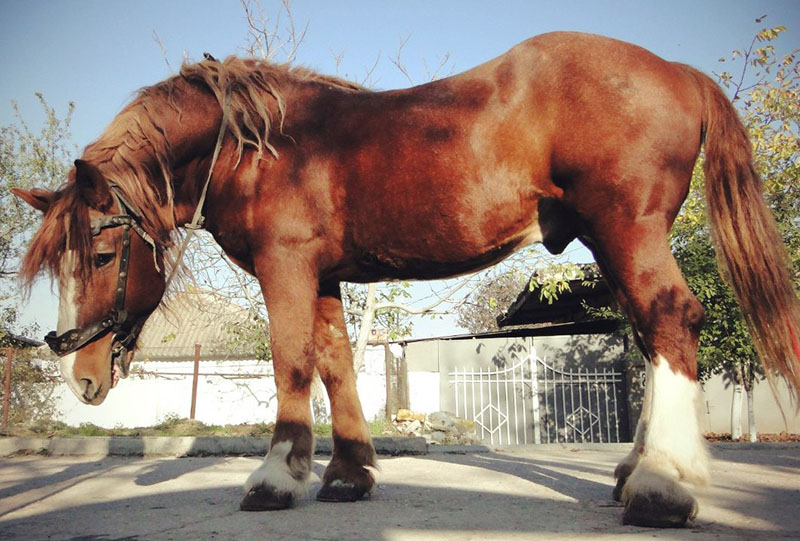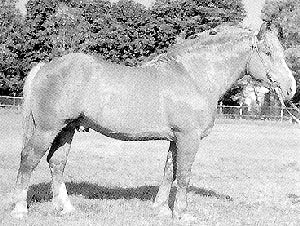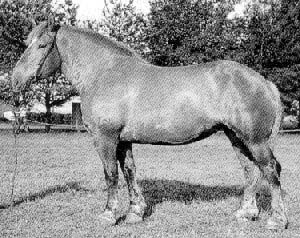Soviet Heavy Draft Horses
This breed was developed during the period from  the '80s and the '90s of the last century up to 1952 when it was recognized as a new
heavy Draft breed. The breeding zone was quite extensive, including Yaroslavl, Vladimir,
Gorki, Penza, Ryazan, Tula, tambov, Voronezh and Orel regions and Mordovia. This was
a zone with a developed industry and intensive agriculture, requiring strong and sufficiently
fast horses of ample size. Success in the breeding of this type of horse was guaranteed
by a stable supply of fodder.
the '80s and the '90s of the last century up to 1952 when it was recognized as a new
heavy Draft breed. The breeding zone was quite extensive, including Yaroslavl, Vladimir,
Gorki, Penza, Ryazan, Tula, tambov, Voronezh and Orel regions and Mordovia. This was
a zone with a developed industry and intensive agriculture, requiring strong and sufficiently
fast horses of ample size. Success in the breeding of this type of horse was guaranteed
by a stable supply of fodder.
Initially, native horses were improved by stallions of the Belgian Brabancon Draft
breed. In 1885, three Brabancan stallions were recorded in stud use in the above zone;
in 1895 they numbered 58, in 1905 - 394 and in 1945 - 891. The breed nucleus was initially
at Khrenov stud and subsequently at Pochinkozsk stud. Mares of multibreed origin (Perchero-Ardennes-Suffolk-Danish
and different varieties of saddle horse) were mated with Brabancon stallions for three
to four generations and the progeny were bred inter se. At the same time grading up
was taking place on a large scale and crossbred stallions were widely used.
In 1936, three state breeding centers, Pochinkovsk, Mordovian and Gavrilovo-Posad, were established. Alexandroz farm in Vladimir region and Yaroslavl farm branched off from the latter. Subsequently, the Pochinkovsk and the Mordovian facilities were transformed into studs.
As the intensification of agricultural production proceeded, demand for massive heavy Drafters was growing. The influence of Brabancon began to spread. In the Baltic zone, new breeds, the Lithuanian and the Estonian Heavy Draft, began to be formed on a different local mare basis.
Modern purebred Soviet Heavy Drafts are distinguished by ample height and clearly
expressed harness type. They are heavily muscled and boned. The average measurements
of breeding stallions at the studs (in cm) are: height withers 163, oblique body length
172, chest girth 215, cannon bone girth 25; mare: 160, 168, 205 and 22.75 respectively.
The live weight of stallions is 850 kg and sometimes reaches 1000 kg; the mares' weight
is 650-750. The Soviet Draft has the following characteristics: the head is average
in size and clean-cut, the neck is average in length, often on the short side and
well muscled; the withers ar low; the back is long, often slightly dipped, the loin
is average in length, the croup is broad, furrowed, drooping and heavily muscled,
the chest is broad, average in depth, the ribs are well sprung. the forelegs are often
pigeon-toed and the hind ones are sickle-hocked. The build is quite coarse, soft and
yet much cleaner and more solid than that of the Brabancon. The predominant colours
are chestnut, brown and bay.
The Soviet Heavy Draft are good utility horses and breeders. the established records are: 2000 m Draft walk with a pull of 150 kg in 11 min 51.8 sec; 2000 m trot with a pull of 50 kg in 4 min 50 sec; Draft endurance with a pull of 300 kg - 1138 m; maximum pull, 851 kg.
The Soviet Heavy Draft mature extremely early and era good milk and meat producers. With normal feeding and management the foal at weaning attain a live weight of 360-400 kg. The breed's record milk yield is 6320 kg. they have a good weight gain per fodder unit but demand good management. they are insufficiently disease resistant and adapt to extreme management conditions worse that other breeds do. The mares' fertility varies from 65 to 76%.
The breed comprises 2 lines and 3 mare families. A new line is now being developed.
The leading breeding centers are Pochikovsk stud in Gorki region and the Mordovian stud farm.
References
Dmitriez, N.G. and Ernst, L.K. (1989) Animal Genetic Resources of the USSR. Animal Production and Health Paper Publ. by FAO, Rome, 517 pp.
